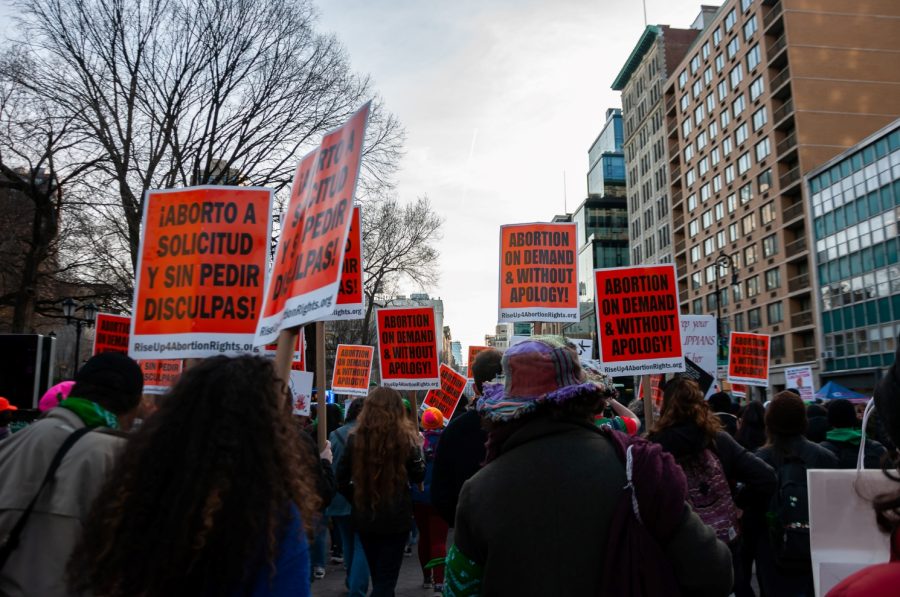Opinion: It’s now or never for reproductive justice
Recent abortion restrictions and bans threaten reproductive rights — especially with the challenging of Roe v. Wade in June 2022. The way to protect reproductive justice lies in intersectionality.
People rally on International Women’s Day for abortion rights. Protesters marched from Union Square Park to Washington Square Park. (Photo by Kiran Komanduri)
March 10, 2022
In May 2021, a Mississippi law to ban abortions after 15 weeks of pregnancy was proposed — two months earlier than allowed by Roe v. Wade’s decision.
On Sept. 1, 2021, Texas implemented a new restrictive abortion ban: Senate Bill 8. The law outlaws abortion after approximately six weeks of pregnancy, the time when people most often realize they are pregnant. The law also encourages individuals to sue anyone who provides abortion care or assists someone in getting an abortion, making it almost impossible for those seeking an abortion to have any support in their decision.
Almost a year after Mississippi’s proposal, on March 3, 2022, Florida lawmakers voted to ban abortions after 15 weeks.
The list of restrictive abortion bans being proposed and passed goes on and on. The fact is that reproductive justice and bodily autonomy are threatened perhaps now more than ever since Roe v. Wade was decided in 1973. The Mississippi law will be heard by the Supreme Court in June this year; depending on how the case unfolds, Roe v. Wade could be overturned. We could lose reproductive autonomy entirely. Even states like New York that have passed legislature to decriminalize abortion and improve access to reproductive health care could find that legislation challenged.
The loss of reproductive rights would have heavy consequences. A ban on legal abortions leads to an increase in unsafe abortions, which account for up to 13.2% of maternal deaths every year, according to the World Health Organization. If unsuccessful, these abortions can also result in pregnancy complications that jeopardize the mother’s health. There is too much at stake; we need to double down and fight for reproductive justice on every front. To do so, we need to understand more about the reproductive justice movement and what it means to have equitable access to health care.
The fight for reproductive justice has been long and hard, with women of color on the frontlines. The term “reproductive justice” was coined in 1994 by SisterSong, a major reproductive justice organization led by Black women. SisterSong defines reproductive justice as “the human right to maintain personal bodily autonomy, have children, not have children, and parent the children we have in safe and sustainable communities.”
Reproductive justice isn’t the same as reproductive rights, and each seeks to secure reproductive health care through different approaches. The reproductive rights approach is mainly focused on the pro-life vs. pro-choice debate and works though legal avenues and policy change. Reproductive justice, however, is more expansive and intersectional. It acknowledges that, alongside legislation and policy, various sociocultural factors including socioeconomic status, geography, citizenship, and gender and sexual identity impact the accessibility of reproductive health care.
What we often fail to understand is that reproductive justice isn’t just about abortion rights. It’s about all reproductive freedoms — equitable access to all sexual and reproductive health care. This includes contraception, comprehensive sex education, STI prevention and care, alternative birth options, prenatal and pregnancy care, domestic violence assistance and proper wages to support families.
Reproductive justice is about access — not just choice. It’s one thing to have the choice to do whatever you want with your body, but it’s another thing to have access to health care that allows you to exercise that choice. Reproductive justice is about ensuring that all demographics have equitable access to the reproductive health care they need.
We need to look at reproductive justice and abortion care through an intersectional lens and recognize the various barriers women of color and queer women face in accessing reproductive health care. Even now, when abortion is legal, many marginalized communities don’t have the ability or agency to access reproductive health care. Cost is a major barrier. An abortion can cost upwards of $500 — even more if there are surgical complications. Many people might not be able to access transportation to abortion centers. There is no choice where there is no access.
Now, more than ever, we need reproductive justice; analyzing power systems and the gender-, sexuality- and race-based dynamics that limit access to health care is an essential part of that fight. Institutions that seek to govern our bodies and take away our autonomy must be dismantled. As Audre Lorde, a Black lesbian poet and activist, said, “There is no such thing as a single-issue struggle, because we do not lead single-issue lives.”
Until the most vulnerable and marginalized individuals have access to health care and are able to live self-determined lives, reproductive justice has not been realized. There’s still time. Roe hasn’t been overturned yet. If you live in a state where restrictive laws are being passed, contact your legislators. Get involved with organizations such as Planned Parenthood, the NARAL Pro-Choice America and SisterSong that are leading efforts to attain reproductive justice. Sign petitions, submit testimonies, raise awareness on social media — there are many ways to join the fight. It’s crucial that we mobilize to preserve the human right to reproductive health care and bodily autonomy.
Contact Aarna Dixit at [email protected].


























































































































































